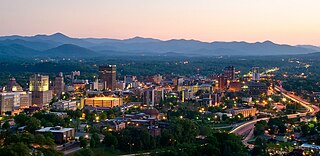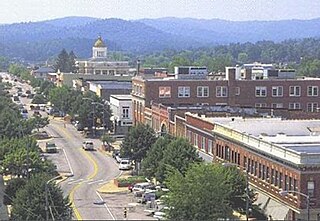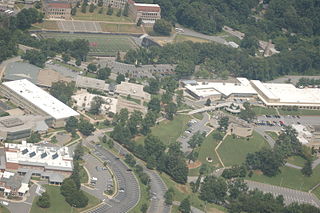
Asheville is a city in and the county seat of Buncombe County, North Carolina, United States. Located at the confluence of the French Broad and Swannanoa rivers, it is the most populous city in Western North Carolina, and the state's 11th-most-populous city. According to the 2020 census, the city's population was 94,589, up from 83,393 in the 2010 census. It is the principal city in the three-county Asheville metropolitan area, which had an estimated population of 417,202 in 2023.

Waynesville is the county seat of Haywood County, North Carolina, United States. It is the largest town in North Carolina west of Asheville. Waynesville is located about 30 miles (50 km) southwest of Asheville between the Great Smoky and Blue Ridge Mountains.

Hendersonville is a city in and the county seat of Henderson County, North Carolina, United States, located 22 miles (35 km) south of Asheville. Like the county, the city is named for 19th-century North Carolina Supreme Court Chief Justice Leonard Henderson.

Marion is a city in and the county seat of McDowell County, North Carolina, United States. Founded in 1844, the city was named in honor of Brigadier General Francis Marion, the American Revolutionary War Hero whose talent in guerrilla warfare earned him the name "Swamp Fox". Marion's Main Street Historic District is listed on the National Register of Historic Places. The population was 7,717 at the 2020 Census.
S. H. Kress & Co. was the trading name of a chain of five and dime retail department stores in the United States established by Samuel Henry Kress. It operated from 1896 to 1981. In the first half of the 20th century, there were Kress stores with ornamented architecture in hundreds of cities and towns.

Quincy Market is a historic building near Faneuil Hall in downtown Boston, Massachusetts. It was constructed between 1824 and 1826 and named in honor of mayor Josiah Quincy, who organized its construction without any tax or debt. The market is a designated National Historic Landmark and a designated Boston Landmark in 1996, significant as one of the largest market complexes built in the United States in the first half of the 19th century. According to the National Park Service, some of Boston's early slave auctions took place near what is now Quincy Market.

Asheville Mall is a regional mall in Asheville, North Carolina. Asheville Mall is located off Interstate 240 in eastern Asheville. It is predominantly a one-story mall. Its anchors are Belk, JCPenney, and two Dillard's locations. A former anchor store, Sears, closed in July 2018. The space still sits vacant as of 2024. It has 132 stores and is the largest mall in Western North Carolina. It also dominates the area's retail.

The Harrah's Cherokee Center – Asheville, previously known as the U.S. Cellular Center and originally as the Asheville Civic Center Complex, is a multipurpose entertainment center, located in Asheville, North Carolina. Opened in 1974, the complex is home to an arena, auditorium, banquet hall and meeting rooms.

Asheville High School is a public high school located in Asheville, North Carolina, United States and is one of two secondary schools in the Asheville City Schools system. Designed by Douglas Ellington, construction of the original building began in 1927 and was completed two years later. The modern addition was built in 1970 and a new cafeteria was finished in 2006. There is a second school located at the same address; the School of Inquiry and Life Sciences at Asheville (SILSA).

Asheville–Buncombe Technical Community College is a public community college in Asheville, North Carolina. Established in 1959, the college is one of the oldest in the North Carolina Community College System and serves Buncombe and Madison counties across five different campuses, although students from anywhere may enroll. As of the 2014–15 school year, the curriculum enrollment was 10,070 and continuing education enrollment was 14,053 students. As of 2019–20, the college is the seventh largest in the North Carolina system and the largest in Western North Carolina. A-B Tech offers more than 120 degrees, diplomas, and certificates.

Douglas Dobell Ellington was an American architect who is noted for his work in the Art Deco style.

Downtown Columbus is the central business district of Columbus, Ohio. Downtown is centered on the intersection of Broad and High Streets, and encompasses all of the area inside the Inner Belt. Downtown is home to most of the tallest buildings in Columbus.

The Thomas Wolfe House, also known as the Thomas Wolfe Memorial, is a state historic site, historic house and museum located at 52 North Market Street in downtown Asheville, North Carolina. The American author Thomas Wolfe (1900–1938) lived in the home during his boyhood. The house was designated a National Historic Landmark in 1971 for its association with Wolfe. It is located in the Downtown Asheville Historic District.

S&W Cafeteria was a Charlotte, North Carolina–based chain of cafeteria-style restaurants. The chain specialized in low-cost, Southern-style food. Branches were located in the Southeastern United States from Washington, D.C. to Atlanta, Georgia.

Asheville City Hall, is a historic Art Deco brick and stone governmental office building located on Court Plaza in Asheville, North Carolina, United States. It serves as the seat of the government of the City of Asheville. It is located in the Downtown Asheville Historic District and was added to the National Register of Historic Places in 1976. The building's unique shape and colorful exterior have made it an iconic Asheville landmark and a symbol for the city, reflected by the use of its silhouette in the city's seal.

Richard Sharp Smith was an English-born American architect, noted for his association with George W. Vanderbilt's Biltmore Estate and Asheville, North Carolina. Smith worked for some of America's important architectural firms of the late 19th century—Richard Morris Hunt, Bradford Lee Gilbert, and Reid & Reid—before establishing his practice in Asheville. His most significant body of work is in Asheville and Western North Carolina, including dozens of buildings that are listed on the National Register of Historic Places or are contributing structures to National Register Historic Districts.

Young Men's Institute Building, also known as the YMI Building, is a historic meeting hall located at Asheville, Buncombe County, North Carolina. It was designed by architect Richard Sharp Smith and built in 1892–1893. It is a 2+1⁄2-story, pebbledash coated masonry building with brick, stone, and wood accents. From its early days, the YMI building has housed shops, residence rooms, meeting rooms, and a wide variety of functions serving the African American community of Asheville. The building was restored and reestablished as the YMI Cultural Center in 1980, and now hosts a variety of intercultural programs and events. It is located in the Downtown Asheville Historic District.
Downtown Asheville Historic District is a national historic district located at Asheville, Buncombe County, North Carolina. The district encompasses about 279 contributing buildings and one contributing object in the central business district of Asheville. It includes commercial, institutional, and residential buildings in a variety of popular architectural styles including Colonial Revival, Queen Anne, and Art Deco.

The Asheville Masonic Temple is a Masonic Temple located in Asheville, North Carolina. Designed by British American architect and Freemason Richard Sharp Smith, the building was opened in April 1915. It is listed in the United States National Register of Historic Places as a contributing building in the Downtown Asheville Historic District.





















